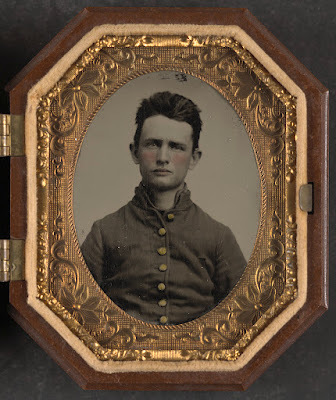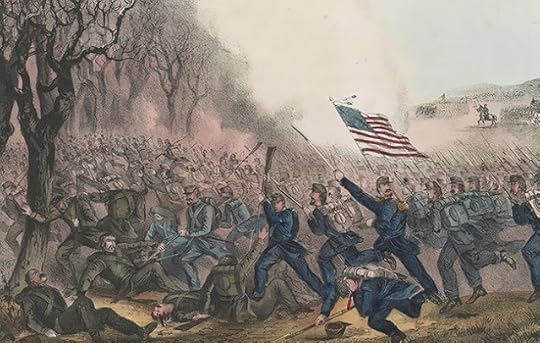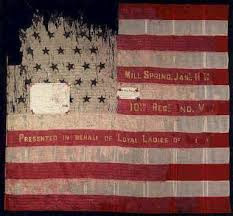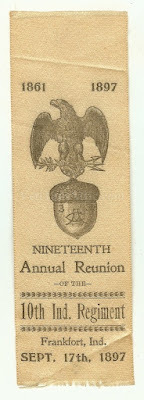The Rebels Flew Right and Left: A Hoosier at Mill Springs
Following the Federal victory at Mill Springs, PrivateWilliam Ruby of the 10th Indiana observed the mad scramble for souvenirsamongst his peers. He proudly reported securing one of the best prizes: aConfederate flag that belonged to a company in the 16th Alabama.
“We gave them such an ungodlyscare in the fight that they left their wagons, tents, trunks, horses, saddles,clothes, guns, pistols, ammunition of all kinds, cannons and in fact everythingimaginable,” he wrote to his father. “A person could not form the least idea ofthe scene which followed. There is hardly anyone but what had a relic or trophyto keep in remembrance of the ever-to-be remembered 19th of January.I captured a splendid banner belonging to the Marion County, Alabama Guards. Iwill present it to old Tippecanoe County, together with another one captured byJohnny Mackessey of our company. I also got a flute worth about $30, a silverwatch, a splendid pistol and case worth about $30. I have several nice littletrophies which I intend sending home at the first opportunity. Swords and longknives are in abundance.”
Private Ruby’s account of thefight at Mill Springs first saw publication in the January 25, 1862, edition ofthe Lafayette Journal & Courier published in Lafayette, Indiana.
 Corporal William Duncan fought at Mill Springs as part of Co. G of the 10th Indiana Volunteer Infantry. The Hoosier would not survive the war, dying June 25, 1864, from a wound sustained 10 days earlier during the Atlanta Campaign.
Corporal William Duncan fought at Mill Springs as part of Co. G of the 10th Indiana Volunteer Infantry. The Hoosier would not survive the war, dying June 25, 1864, from a wound sustained 10 days earlier during the Atlanta Campaign. Camp Beech Grove, inside Zolly’s Fortifications, Mill Spring,Kentucky
January 21, 1862
Dear father,
No doubt youare anxious to hear of my whereabouts. I can only say that I weathered thestorm and came out without a scratch. I shot two seceshers that I know of; I togetherswith others saw them fall. One was a color-bearer who waved his flag in ourfaces when I took good aim and down he went.
Last Sundaymorning, immediately after roll call, one of Woolford’s cavalry came into campwith the intelligence that a large force was advancing towards us. We had nosooner received the news than we heard the pickets firing briskly. The longroll was beat, the regiment formed in line of battle and started immediately tothe rescue of Co. K who were out on picket duty. We no sooner reached the sceneof action than Colonel Kise gave the command to “fire!” which the boys did witha will. Our situation was upon a small hill, the enemy on the hill just above us,but out of sight on account of the density of the underbrush. After a fight ofnear an hour, we were obliged to retreat, as the other regiments failed to comeup to sustain us.
We held ourground against a force of 9,000 strong. Before we retreated, they flanked usright and left so that we were in a crossfire, it was in this predicament thatwe lost most of our men. When we retired the 4th Kentucky came upand took our place, where they did good service. They fought valiantly as anytroops could have done. No sooner had we reached our camp than we were againcalled to rally, which we did with alacrity. No sooner had we formed in linethan General Thomas ordered us forward to sustain the 4th Kentucky,who were now nearly out of ammunition. We went forward to the front, squattedbehind a fence and pecked away at the Rebels whenever we got a chance.

In about half an hour, we wereordered to the woods where we again went on double quick. From this position,we were ordered to the left from there we were commanded to “charge bayonet”which we did with a yell and a good will. The Rebels flew right and left. Ourboys followed them, keeping up a continual fire. The Rebels fell all around;some of them were spunky, held their ground as though they intended stayingwith us a while, which in fact they did. After driving the Rebels out of thewoods, we kept after them through an open field when they squatted behind afence, when our boys, the 4th Kentucky, and 9th Ohiowhich had just come up, took to stumps and old dead trees.
The last half hour’s firing wasthe hottest and heaviest of all. During the engagement, our artillery firedsome 25-30 shells which made a general scatter among the seceshers. Theyreturned the fire with interest. In their flight the Rebels left two cannon andguns innumerable. After the Rebels fled, we followed them about half a milewhen we came to a halt, took breakfast at the expense of the party ‘cleaned out’which they had left behind them a short distance, intending (as they said) toreturn for it after they had given us what we needed and taken breakfast in ourcamp. Old General Zollicoffer said at starting that he would take breakfast inour camp or in hell that morning. I think he must certainly have taken hisbreakfast in the latter place as he was killed early in the engagement.
Colonel Speed Fry of the 4thKentucky claims the killing of Zollicoffer; others say that it was an Enfieldball that put out his lamp of life. One thing certain, Zollicoffer is dead.General George Crittenden was wounded and is a prisoner in our camp. We pursuedthe Rebels; they fled for their fortifications, but no officer could get themout of their bunks after they had once reached them in safety. The roads wepassed over were the worst and muddiest that I ever traveled or ever want to again.
 National colors presented to the 10th Indiana by the Loyal Ladies of Lafayette; note the Mill Spring battle honor above the regimental identification.
National colors presented to the 10th Indiana by the Loyal Ladies of Lafayette; note the Mill Spring battle honor above the regimental identification. We came in sight of oldZollicoffer’s works just before dark and could see the Rebels at work inside oftheir entrenchments. They threw two shells at us but did us no damage. Ourartillerists threw about 40 rounds at them, which made them get up andskedaddle. All night we could see them crossing the river on their ferry boats.As soon as daylight set in, we threw eight or ten more shells at them as theycrossed the river. One shell set their boat on fire. After that we could seethe Rebels swimming the river. One whole regiment pitched in at once.
None of them got their gunsashore; they started in with them but lost them in the river. Over 3,000 gunswere lost in the Cumberland and over 100 horsemen drowned. On the night ofJanuary 19, our regiment lay out, Mother Earth for a bed, the bright canopy ofheaven above for a covering, and slept first rate, dreamed of home and seeingyou all. On the morning of the 20th, we took our frugal breakfastwhich consisted of a hard cracker and a piece of bacon, roasted on the coals.
About 10 o’clock, we formed inline and marched over to the camps lately vacated by the Confederates. Onceinside, we began to look around and were astonished to see how or what could possessa set of men to leave works as strong as they had here on the riverside. Theyhad natural fortifications and on the side from which we would have to attackthem were strong enough to hold with a small force against a host, we couldnever have taken them without a heavy loss on our side. And after we would havetaken their works on this side of the river, they could have held the otherside as they had heavy works all around them, whilst on the river side, theworks were almost impregnable.
They could have sunken everyboat that we could have got or attempted to use, but as luck would have it, we gavethem such an ungodly scare in the fight that they left their wagons, tents,trunks, horses, saddles, clothes, guns, pistols, ammunition of all kinds,cannons and in fact everything imaginable. A person could not form the leastidea of the scene which followed. There is hardly anyone but what had a relicor trophy to keep in remembrance of the ever-to-be remembered 19thof January.

Of our officers (that of Co. E)I can say this much: they behaved nobly, did their duty, none could have donebetter. Our loss in the 10th Indiana was 13 killed and 80 wounded,two of whom have since died. Our company lose one killed and six wounded.Lieutenant Louis Johnson has a slight scratch on the right arm. On our firstfight in the morning, we held our ground one hour and 40 minutes against 9,000men. Our force was only 700. One prisoner, a Mississippian whom I took, said tome, “By God, boys, you fight like hell. You are too heavy for us!” We had tocontend against Mississippians, South Carolinians, Alabamians, Louisianans,Tennesseans, and Kentuckians. The Hoosiers beat all and the 10thIndiana gets all the praise, the 4th Kentucky a share.
After the battle, General GeorgeThomas rode up before us. He told General Mahlon Manson that he never saw suchfighting in his life as we did and said, “three cheers for the brave Indianans.”Everyone says that we do beat hell in a fight. I captured a splendid bannerbelonging to the Marion County, Alabama Guards [Co. G or K, 16th Alabama].I will present it to old Tippecanoe County, together with another one capturedby Johnny Mackessey of our company. I also got a flute worth about $30, asilver watch, a splendid pistol and case worth about $30. I have several nicelittle trophies which I intend sending home at the first opportunity. Swordsand long knives are in abundance.
Mess No. 4 is quartered in a hutlately occupied by an Alabama captain. The Rebels had erected winter quartersand intended staying here. We captured over 1,600 head of horses and mules, 500wagons, and 14 cannons. Provisions are plenty- we have everything that we couldwish for and have had a good old time reading Secesh letters. The Rebels puttheir loss at over 2,000; we have picked up and buried over 250. We have about60 prisoners in our camp besides others; they say their loss is heavy.
To learn more about the Battle of Mill Springs, please check out these related posts:
Trembling in Our Very Boots: A Hoosier Describes Mill Springs (10th Indiana)
Nip and Tuck with the 2nd Minnesota at Mill Springs
A Librarian's First Battle: At Mill Springs with the 2nd Minnesota
A Tale of Two Colonels: A Blue & Gray View of Mill Springs (16th Alabama and 2nd Minnesota)
Failure at Fishing Creek: A Mississippi Tiger's Take on Mill Springs (15th Mississippi)
The Odyssey of Zollicoffer's Body
WilliamFranklin Ruby was born December 2, 1840, in Lafayette. Tippecanoe Co., Indianaat the age of 16, set out to make his fortune in Texas where he engaged in thedrug business for four years, but left the now now-seceded state on April 12, 1861.The overland journey took nearly three months to complete, Ruby arriving in Lafayetteon July 24, 1861.
Ruby enlisted as a private inCo. E of the 10th Indiana Volunteer Infantry on September 18, 1861.Promoted to regimental commissary sergeant on March 20, 1863, he mustered outwith the regiment September 19, 1864, at Indianapolis, Indiana. He had a veryactive service with the 10th Indiana, taking part in engagements atMill Spring, Perryville, Hoover’s Gap, Chickamauga, and throughout the Atlantacampaign. Cited for heroism is distributing cartridges to the regiment atPerryville, Ruby suffered a severe wound at Resaca in May 1864. “He was sent toGallatin, Tennessee with a train of supplies for the troops who had gone afterMorgan’s band at Muldraugh’s Hill and received a telegram to get back toElizabethtown as fast as possible as Morgan was making for the railroad at thatpoint to cut off and capture the train and supplies, but he won the race byabout 20 minutes and saved the train,” his obituary stated.
In April 1865 he wascommissioned as quartermaster of the 154th Indiana, one of Indiana’slast Civil War regiments, and served just a few months before mustering out ofservice for the final time August 4, 1865, at Winchester, Virginia. LieutenantRuby passed away October 13, 1924, in his hometown of Lafayette and is buriedat Greenbush Cemetery.
Source:
Letter from Private William Franklin Ruby, Co. E, 10thIndiana Volunteer Infantry, Lafayette Journal & Courier (Indiana), January25, 1862, pg. 3
Daniel A. Masters's Blog
- Daniel A. Masters's profile
- 1 follower



